Tiny Houses
Minimalistic Living: Mastering the Art of Furnishing a Tiny House
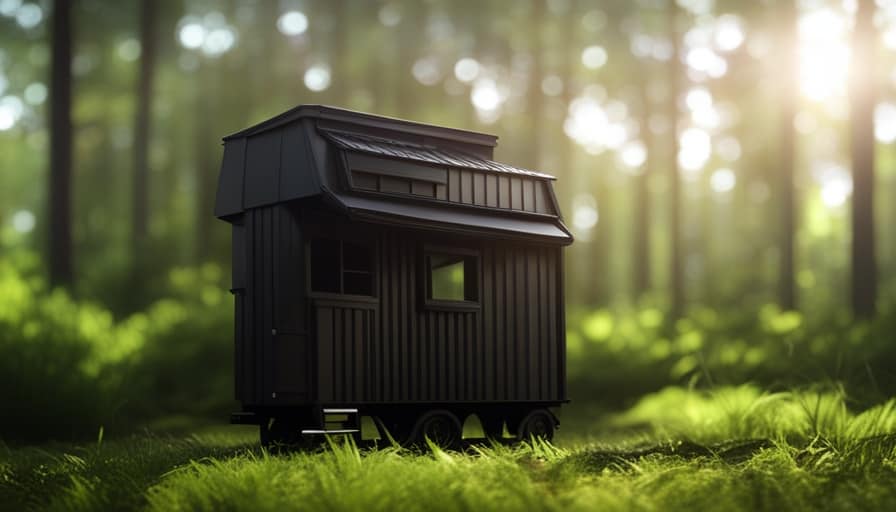
We’ve discovered the secret to making the most of limited space: minimalistic living. In this article, we’ll show you how to master the art of furnishing a tiny house.
From assessing your space to carefully choosing your pieces, we’ll guide you through the process of creating a functional and stylish home.
Embrace multipurpose furniture, opt for compact appliances, and prioritize quality over quantity.
With our tips and tricks, you’ll be amazed at how much you can do with less.
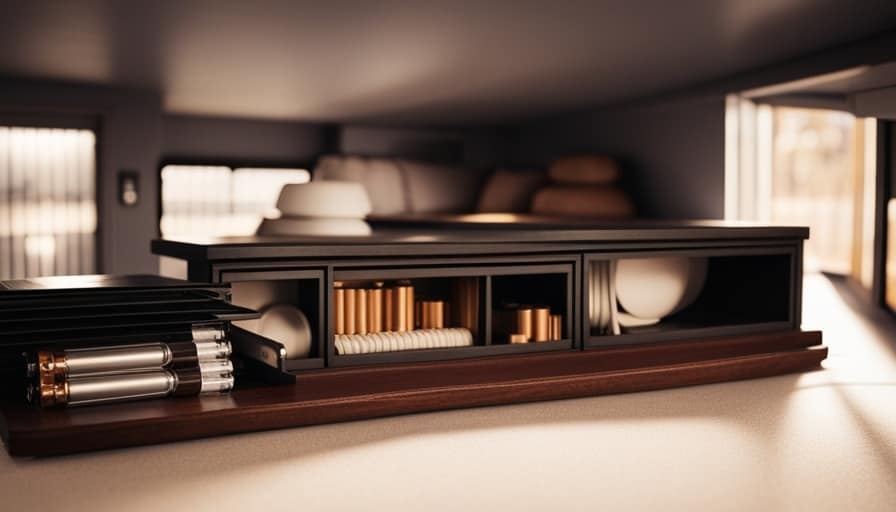
Key Takeaways
- Maximize limited space with multifunctional furniture and storage solutions
- Prioritize quality and durability when choosing furnishings for a tiny house
- Optimize functionality and comfort by strategically arranging furniture and maximizing natural light
- Incorporate lightweight materials and customizable storage solutions for a more spacious and adaptable living environment
Assessing Your Space
We’ll start by measuring the dimensions of our living area to accurately assess our space. This step is crucial in maximizing the functionality and efficiency of a tiny house.
By understanding the exact measurements, we can plan and utilize every inch effectively. Efficient storage becomes paramount in small spaces, as it allows us to keep our belongings organized and easily accessible. Whether it’s utilizing under-the-bed storage, wall-mounted shelves, or multifunctional furniture, every nook and cranny should be utilized.
Another important aspect to consider is maximizing natural light. Natural light not only creates a sense of openness and spaciousness, but it also reduces the need for artificial lighting during the day. Installing large windows, using light-colored curtains, and strategically placing mirrors can all help in bringing in more natural light and making the space feel more inviting and airy.
Carefully Choosing Your Pieces
Let’s carefully select the furniture and decor pieces that will best suit our tiny house and optimize the available space. When choosing pieces for our minimalist living space, it’s important to consider both storage solutions and minimalist aesthetics.
Here are some key factors to keep in mind:
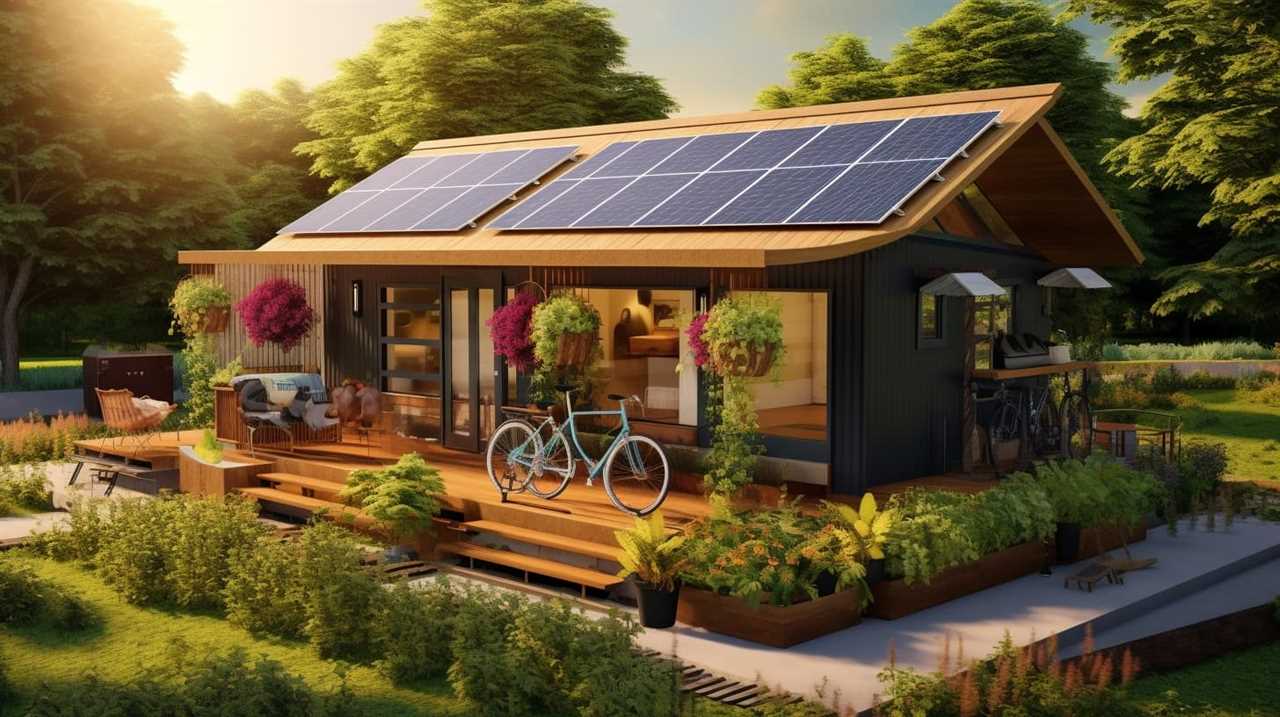
-
Multifunctional Furniture: Look for pieces that serve multiple purposes, such as a sofa that can also be used as a guest bed or storage ottomans that provide extra seating and hide clutter.
-
Vertical Storage: Utilize wall space by installing shelves and hooks to keep items off the floor and maximize storage potential.
-
Compact and Foldable: Opt for furniture that can be easily folded and stored away when not in use, like collapsible tables and chairs.
-
Minimalist Design: Choose furniture with clean lines and a neutral color palette to maintain a minimalist aesthetic and create a sense of spaciousness.
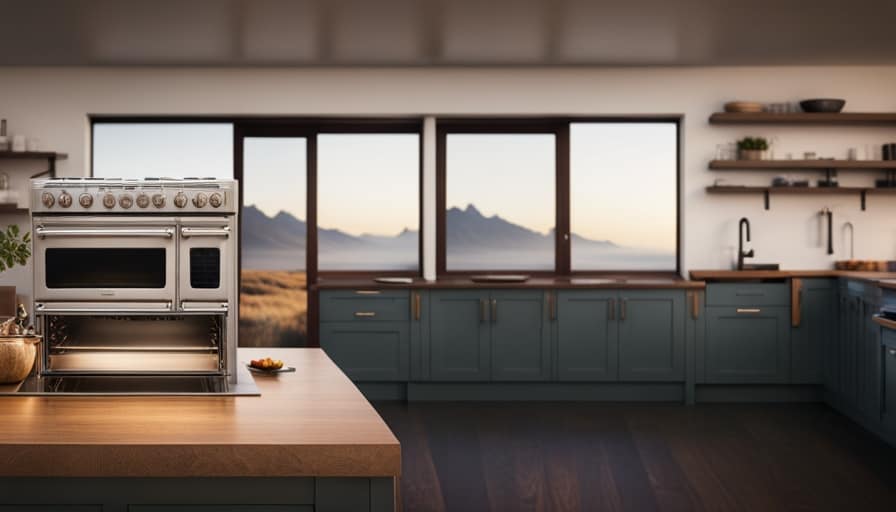
Embracing Multipurpose Furniture
When it comes to furnishing a tiny house, one of the most important aspects to consider is utilizing multipurpose furniture.
These space-saving solutions not only maximize the limited square footage but also add functionality to each piece.
From convertible sofas that turn into beds to coffee tables with hidden storage compartments, embracing multipurpose furniture allows us to create a practical and stylish living space without compromising on design.
Space-Saving Furniture Solutions
We love utilizing space-saving furniture solutions and embracing multipurpose furniture in our tiny house. It allows us to make the most out of our limited space while still having functional and stylish furniture. Here are four space-saving furniture solutions that have transformed our tiny house:

-
Modular Furniture: Modular furniture pieces, such as modular sofas or shelving units, are versatile and can be rearranged to fit different needs. They offer flexibility and can easily adapt to our changing lifestyle.
-
Hidden Storage: We’ve incorporated furniture with hidden storage compartments, like ottomans with built-in storage or beds with drawers underneath. This helps us maximize storage space and keep our tiny house clutter-free.
-
Wall-Mounted Furniture: Wall-mounted furniture, like fold-down tables or wall-mounted desks, are great space-saving solutions. They can be easily folded up when not in use, freeing up valuable floor space.
-
Convertible Furniture: Convertible furniture, such as sofa beds or dining tables that can be extended or collapsed, are perfect for small spaces. They serve multiple functions, allowing us to maximize both seating and sleeping areas.
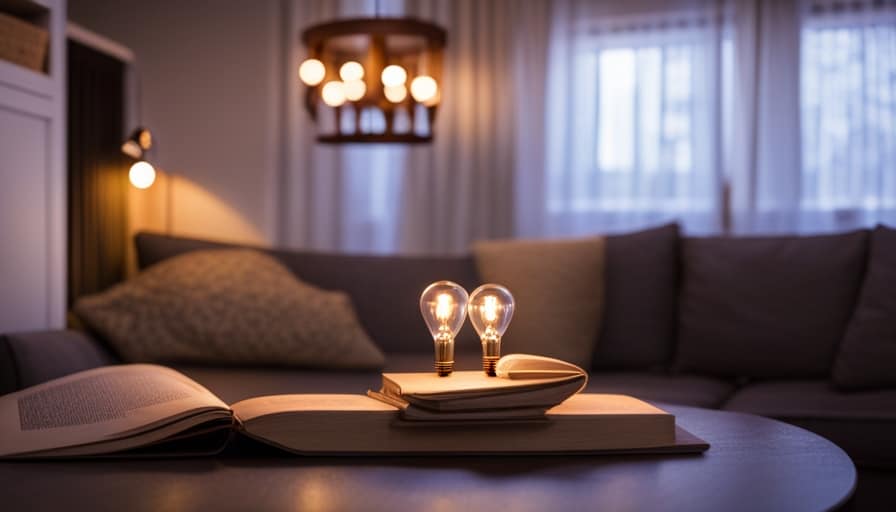
Functionality Meets Design
In order to maximize our space while maintaining a stylish aesthetic, we’ve embraced multipurpose furniture that combines functionality and design.
Balancing aesthetics and maximizing storage are key considerations when furnishing a tiny house. Multipurpose furniture allows us to make the most of our limited space by serving multiple functions.
For example, a sofa with built-in storage compartments not only provides seating but also offers a convenient place to store blankets, pillows, and other items.
Similarly, a coffee table that doubles as a desk or dining table can save valuable floor space while still providing a practical surface for various activities.
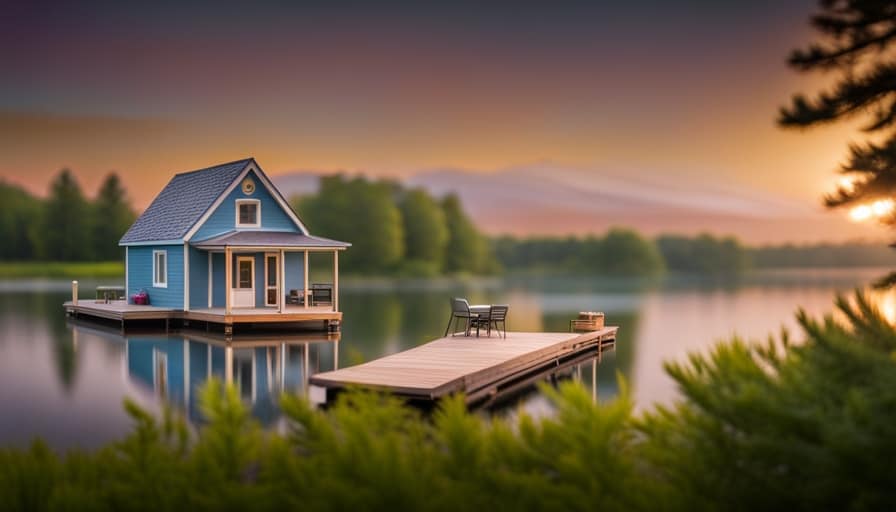
Opting for Compact Appliances
For our tiny house, we decided to go with compact appliances to maximize space efficiency. Choosing the right appliances for a small living space is crucial, as they can make a significant difference in functionality and overall comfort. Here are some compact appliance options to consider for your tiny house:
-
Compact Refrigerator: A smaller-sized fridge will save space while still providing adequate storage for food and beverages.
-
Combination Washer-Dryer: Opting for a unit that combines both washing and drying functions will help save space and eliminate the need for a separate dryer.
-
Induction Cooktop: These energy-efficient appliances are compact, easy to clean, and provide precise temperature control for cooking meals.

-
Compact Dishwasher: A smaller dishwasher can fit perfectly in a tiny house kitchen, making it easier to clean up after meals without taking up too much space.
By choosing compact and energy-efficient appliances, you can optimize the functionality of your tiny house without sacrificing convenience or comfort.
Now, let’s explore the next section about prioritizing quality over quantity.
Prioritizing Quality Over Quantity
When it comes to furnishing a tiny house, one of the key principles to keep in mind is prioritizing quality over quantity. This means carefully selecting essential furnishings that are durable and built to last, rather than filling up the limited space with many lower-quality items.

Choosing Essential Furnishings
We love prioritizing quality over quantity when choosing essential furnishings for our tiny house. It’s important to assess the space limitations and maximize storage capacity to ensure our home remains functional and clutter-free. Here are four key considerations when selecting furnishings:
-
Multifunctional pieces: Opt for furniture that serves multiple purposes, such as a sofa that doubles as a guest bed or a dining table that can be folded away when not in use.
-
Customizable storage solutions: Look for furniture with built-in storage compartments or shelves that can be adjusted to accommodate different items.
-
Compact design: Choose furnishings that are specifically designed for small spaces, with slim profiles and efficient use of space.
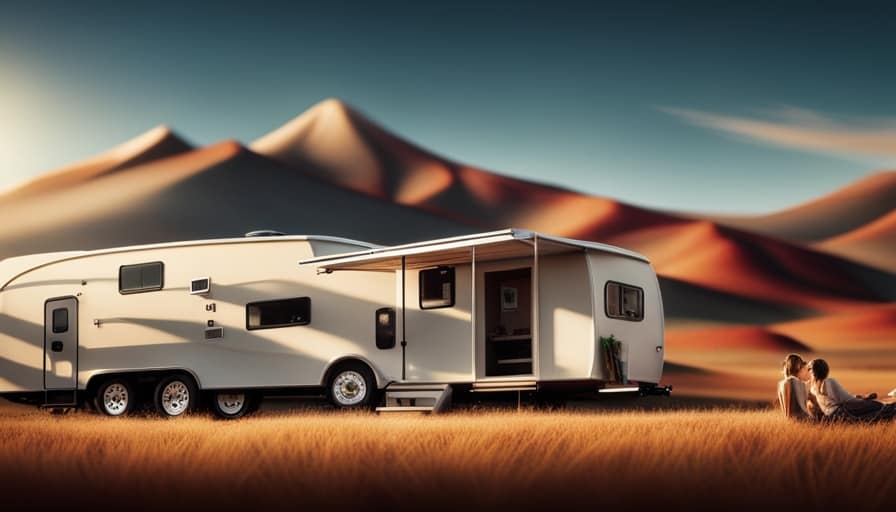
-
Durable materials: Invest in quality materials that can withstand daily wear and tear, ensuring longevity and reducing the need for frequent replacements.
Quality Vs. Space Optimization
Our goal is to prioritize quality in furnishing our tiny house, so we carefully consider how to optimize the limited space available. When it comes to quality vs. affordability, we believe that investing in high-quality furnishings is essential for creating a comfortable and durable living environment. This allows us to make the most of our limited space without compromising on comfort or style. One way we achieve this is by maximizing natural light, which not only enhances the overall aesthetic but also creates an illusion of a larger space. To achieve this, we strategically place windows and use light-colored curtains or blinds to allow as much natural light as possible. By prioritizing quality and optimizing our space, we can create a tiny house that is functional, stylish, and enjoyable to live in.
| Advantages of Prioritizing Quality | Advantages of Space Optimization | Advantages of Maximizing Natural Light |
|---|---|---|
| Durability and longevity | Efficient use of limited space | Creates illusion of a larger space |
| Enhanced comfort and functionality | Improved organization and storage | Enhances overall aesthetic |
| Higher resale value | Increased flexibility | Boosts mood and well-being |
Functional Multi-purpose Items
Although we prioritize quality over quantity, we can still find functional multi-purpose items to furnish our tiny house. Here are four examples of such items that will help maximize space and serve multiple purposes:
-
Convertible Furniture: Investing in furniture that can transform or adapt to different functions is essential in a tiny house. For example, a sofa that can convert into a bed or a dining table that can fold down when not in use.
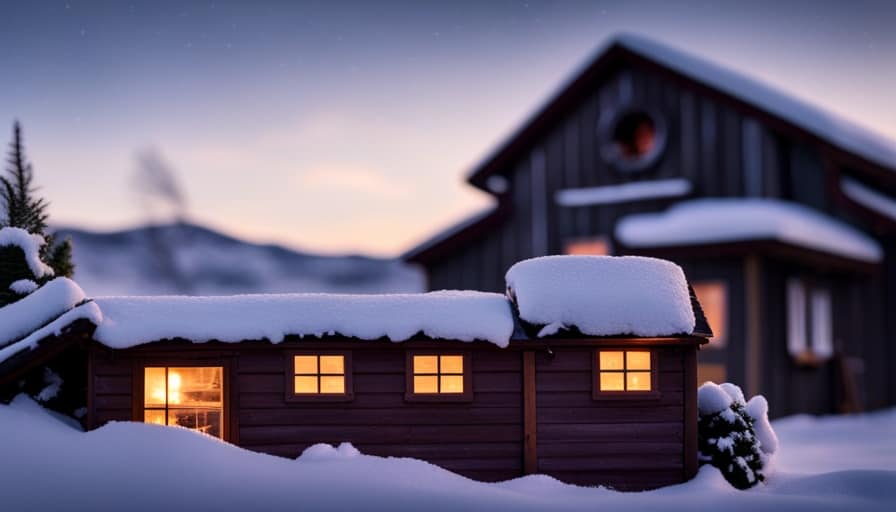
-
Wall-mounted Desks: A wall-mounted desk provides a functional workspace without taking up valuable floor space. It can be folded up against the wall when not in use, creating more room for other activities.
-
Hidden Storage: Utilizing hidden storage solutions is crucial in a small living space. Look for furniture with built-in storage compartments, such as ottomans with hidden compartments or beds with drawers underneath.
-
Multi-purpose Kitchen Tools: Opt for kitchen tools and appliances that serve multiple functions, such as a blender that can also function as a food processor. This way, you can minimize the number of items you need while still being able to prepare a variety of meals.
Incorporating Lightweight Materials
To create a more spacious and adaptable living environment, we can incorporate lightweight materials into the furnishings of our tiny house.

Lightweight construction allows for mobility and flexibility, making it easier to rearrange and customize the space according to our needs.
By using sustainable materials like bamboo or recycled plastics, we not only reduce the overall weight of the furniture but also minimize our environmental impact. These materials aren’t only durable but also aesthetically pleasing, adding a touch of elegance to our tiny house.
Additionally, lightweight materials can be easily transported or moved around when needed.
Now that we’ve explored the benefits of incorporating lightweight materials, let’s move on to the exciting topic of exploring customization options for our tiny house.
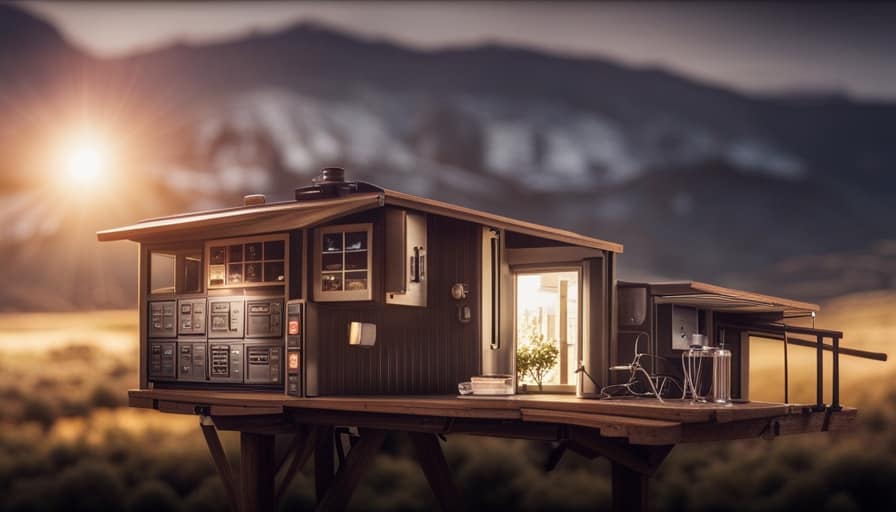
Exploring Customization Options
We can personalize our tiny house by exploring customization options and incorporating unique design elements. Customizing our space not only allows us to create a home that reflects our personal style, but it also offers a range of benefits that enhance our living experience.
Here are four reasons why customization is essential for personalizing your space:
-
Tailored Storage Solutions: Customizing storage options ensures that every inch of our tiny house is optimized for efficiency. From built-in shelves to hidden compartments, we can create storage solutions that perfectly fit our needs.
-
Multifunctional Furniture: Customizing furniture allows us to maximize functionality in our limited space. From convertible beds to foldable tables, we can create pieces that serve multiple purposes, making our tiny house more versatile.

-
Unique Aesthetic: Customization allows us to infuse our personality into our tiny house. We can choose colors, materials, and finishes that resonate with our style, creating a unique and inviting space.
-
Efficient Use of Space: By customizing our tiny house, we can make the most of every square foot. Whether it’s designing custom-built furniture or incorporating space-saving features, customization ensures that our small space is utilized to its fullest potential.
Maximizing Vertical Storage
We can effectively utilize vertical space by installing tall shelves and utilizing wall-mounted storage solutions.
In a tiny house, where every inch counts, maximizing vertical storage is essential. One way to do this is by incorporating tall shelves that go all the way up to the ceiling. These shelves can be used to store items that aren’t frequently used, such as seasonal clothing or extra kitchen appliances.
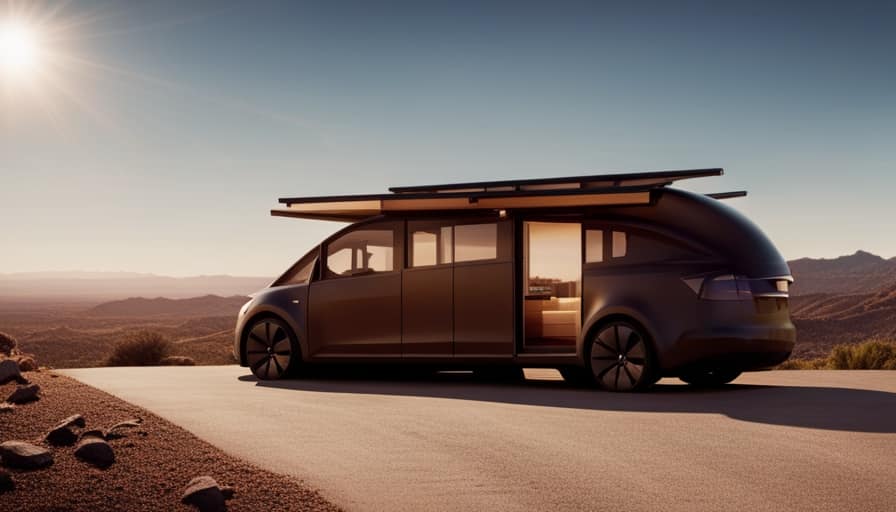
Another option is to utilize wall-mounted storage solutions, such as hanging organizers or hooks. These can be used to hang coats, bags, or even pots and pans in the kitchen.
Additionally, vertical gardening can be a great way to utilize wall space and bring some greenery into your tiny house. By using hanging planters or wall-mounted plant shelves, you can create a beautiful and functional vertical garden.
Frequently Asked Questions
How Can I Make the Most Out of My Limited Storage Space in a Tiny House?
To make the most out of our limited storage space in a tiny house, we focus on small space organization and maximizing storage solutions. This allows us to efficiently utilize every inch of our living space.
Are There Any Specific Materials That Are Best Suited for Furnishing a Tiny House?
When it comes to furnishing a tiny house, there are definitely materials that work better than others. We’ve found that using lightweight and versatile materials is the key to maximizing space and creating functional furniture.
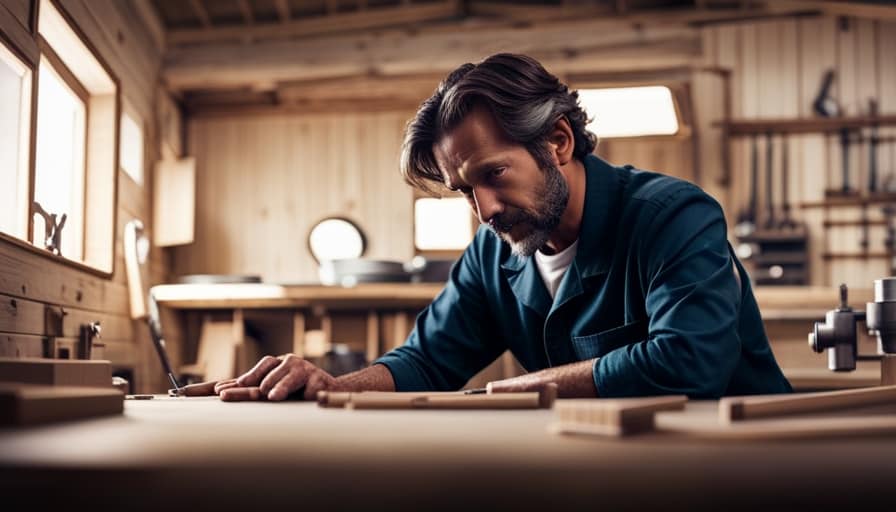
What Are Some Creative Ways to Incorporate Customization Options in a Tiny House?
When it comes to furnishing a tiny house, we’ve found that incorporating customization options can make a big difference. Some creative ways to do this include using creative storage solutions and opting for customizable furniture options.
How Can I Ensure That the Furniture I Choose for My Tiny House Is of High Quality?
Choosing high quality furniture for our tiny house can be challenging. We look for durable materials like solid wood or metal, sturdy construction, and reliable mechanisms. Reviews and recommendations from experienced tiny house owners help us make informed decisions. Multipurpose furniture maximizes functionality and storage, enhancing our minimalist lifestyle.
Can You Provide Tips on How to Make the Most of Vertical Storage in a Tiny House?
To maximize vertical storage in a tiny house, we recommend utilizing wall-mounted shelving for small spaces. It’s a practical and space-saving solution that allows you to keep your belongings organized and easily accessible.
Conclusion
In conclusion, mastering the art of furnishing a tiny house is about more than just saving space; it’s about embracing a minimalist lifestyle.
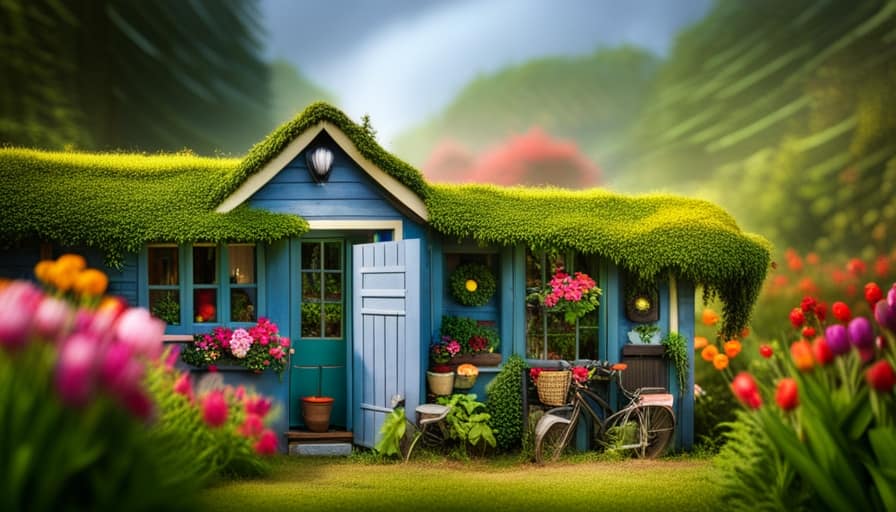
By carefully choosing multipurpose furniture, compact appliances, and lightweight materials, we can create a visually stunning and functional living space.
Just as each piece in a puzzle contributes to the whole picture, every choice we make in furnishing our tiny house symbolizes our commitment to simplicity and mindful living.
I’m Theodore, and I love tiny houses. In fact, I’m the author of Tiny House 43, a book about tiny houses that are also tree houses. I think they’re magical places where imaginations can run wild and adventures are just waiting to happen.
While tree houses are often associated with childhood, they can be the perfect adult retreat. They offer a cozy space to relax and unwind, surrounded by nature. And since they’re typically built on stilts or raised platforms, they offer stunning views that traditional homes simply can’t match.
If you’re looking for a unique and romantic getaway, a tree house tiny house might just be the perfect option.
Tiny Houses
How Do You Maintain Temperature in a Tiny House While Traveling

As a traveler in a tiny house, it is essential to ensure a comfortable temperature for a pleasant journey. It is akin to nurturing the warmth at the core of your home.
In this article, I’ll share practical tips on insulation, heating options, cooling solutions, maximizing airflow, and smart thermostat systems. With these tricks up your sleeve, you’ll be able to create a haven of comfort, no matter where your tiny house takes you.
Let’s embark on this temperature control adventure together!
Key Takeaways
- Insulation is essential for maintaining temperature control in a tiny house while traveling.
- Prioritize energy-efficient materials with a high R-value for optimal temperature regulation.
- Consider heating options such as propane-fueled furnaces, portable heaters, or solar-powered heating systems.
- Cooling solutions like portable air conditioners and solar-powered fans are practical and efficient for maintaining a comfortable indoor environment.
Insulation: The Key to Temperature Control
I can’t stress enough how important insulation is for maintaining temperature control in a tiny house while traveling. When it comes to insulation types, there are a few options to consider.
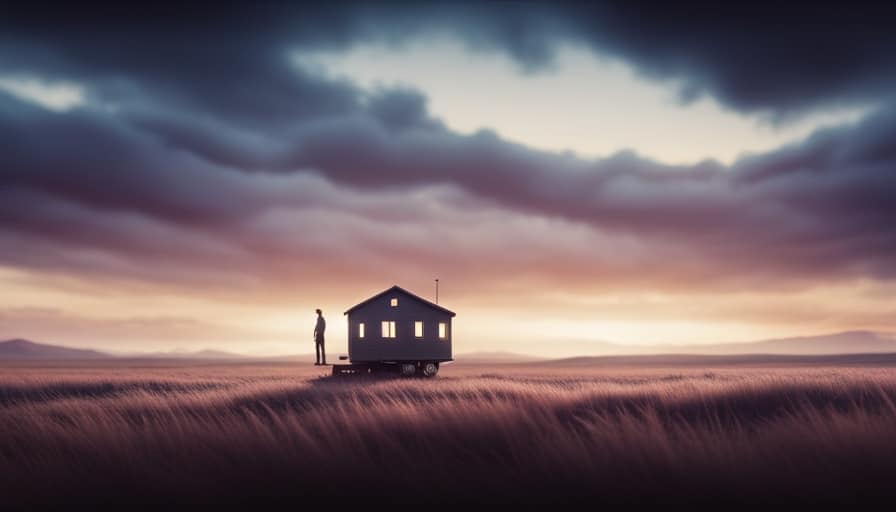
One popular choice is spray foam insulation, which creates an airtight seal and provides excellent thermal resistance. Another option is fiberglass insulation, which is cost-effective and easy to install.
Whichever insulation type you choose, it’s crucial to prioritize energy-efficient materials. Look for insulation that has a high R-value, which measures its thermal resistance. This will help keep your tiny house cool in the summer and warm in the winter, reducing the need for excessive heating or cooling.
Speaking of heating, let’s now explore the various options available for tiny house travelers.
Heating Options for Tiny House Travelers
One of the most popular heating options for tiny house travelers is a propane-fueled furnace. These furnaces are compact and efficient, making them ideal for small spaces. They provide a steady source of heat and can easily be controlled to maintain a comfortable temperature. However, there are other heating options available for tiny house travelers that are worth considering. Portable heaters are another efficient heating option for small spaces. They are easy to move around and can be used in different areas of the tiny house as needed. Another sustainable solution for tiny house travelers is solar powered heating. By harnessing the power of the sun, solar heating systems can provide warmth without relying on propane or electricity. They are environmentally friendly and can help save on energy costs.

| Heating Option | Efficiency | Sustainability |
|---|---|---|
| Propane-fueled furnace | Compact and efficient | N/A |
| Portable heaters | Efficient and portable | N/A |
| Solar powered heating | Relies on solar energy | Sustainable |
Cooling Solutions for Life on the Road
One of the most effective ways to stay cool while traveling in a tiny house is by using a portable air conditioner. These compact units are designed to provide cooling relief in small spaces and can be easily moved from room to room.
Portable air conditioners work by pulling in warm air, cooling it, and then releasing the cooled air back into the room. They typically come with adjustable settings, allowing you to control the temperature and fan speed to your comfort level.
Another option for cooling your tiny house on the road is by using solar-powered fans. These fans are powered by the sun’s energy and can help circulate air, providing a refreshing breeze. They’re eco-friendly and can be easily installed in windows or mounted on the walls of your tiny house.
When it comes to beating the heat while traveling, portable air conditioners and solar-powered fans are practical and efficient solutions.
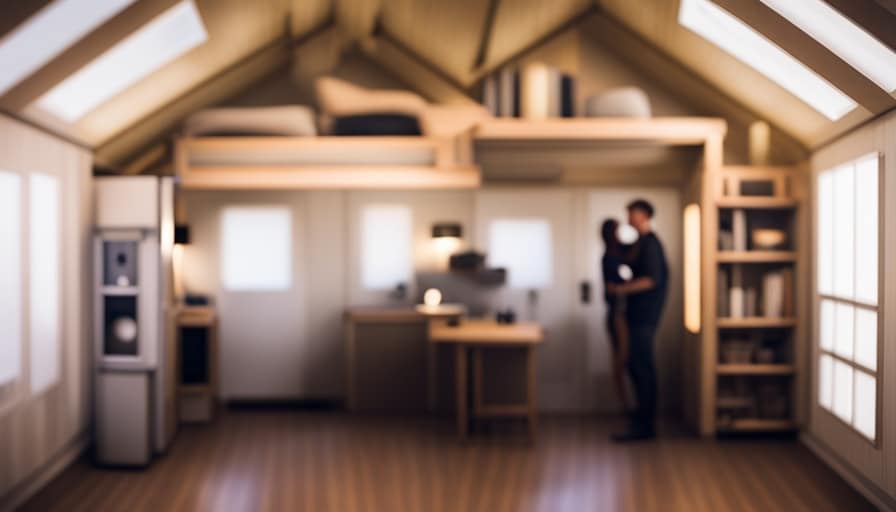
Maximizing Airflow: Ventilation Tips for Tiny Houses
To ensure optimal airflow and ventilation in a tiny house while traveling, it’s important to implement these effective tips.
Ventilation techniques play a crucial role in maintaining a comfortable indoor environment. One of the best natural cooling methods is to utilize windows strategically. Open windows on opposite sides of the house to create cross ventilation, allowing fresh air to flow in and hot air to escape.
Installing roof vents or skylights can also help circulate air and remove excess heat. Another tip is to use portable fans or ceiling fans to promote air movement. Placing a fan near a window can help draw in cool air from outside.
Additionally, using light-colored curtains or shades on windows can reflect heat and prevent the greenhouse effect.
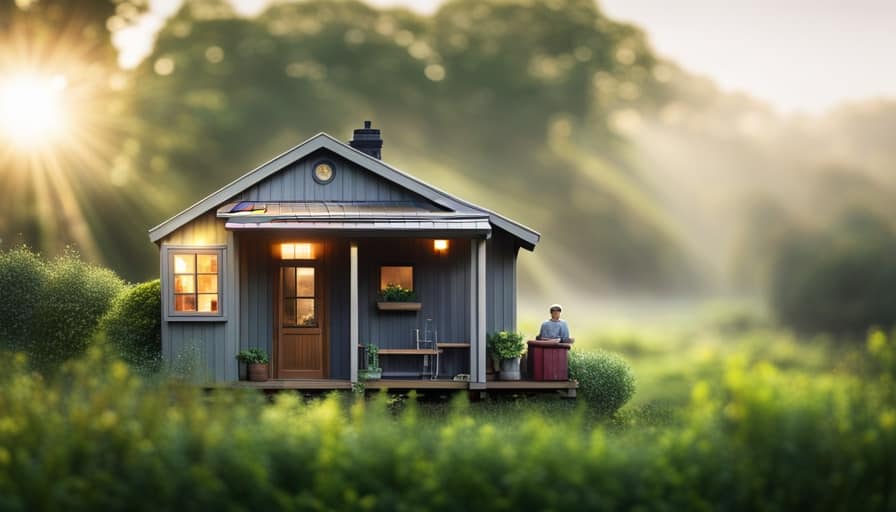
Smart Thermostat Systems for Temperature Regulation in Tiny Homes
As I explore ways to maintain temperature in my tiny house while traveling, I’ve discovered that smart thermostat systems are an excellent solution. These systems not only provide convenience but also offer energy-efficient solutions that can save you money in the long run.
Here are some reasons why smart thermostat systems are worth considering:
-
Smart home automation: With a smart thermostat, you can control the temperature of your tiny house remotely using your smartphone or voice commands, making it convenient and easy to ensure your home is comfortable before you arrive.
-
Energy efficiency: Smart thermostats are designed to optimize energy usage by learning your schedule and preferences. They can adjust the temperature settings accordingly, ensuring that your tiny house is always at the right temperature without wasting energy.
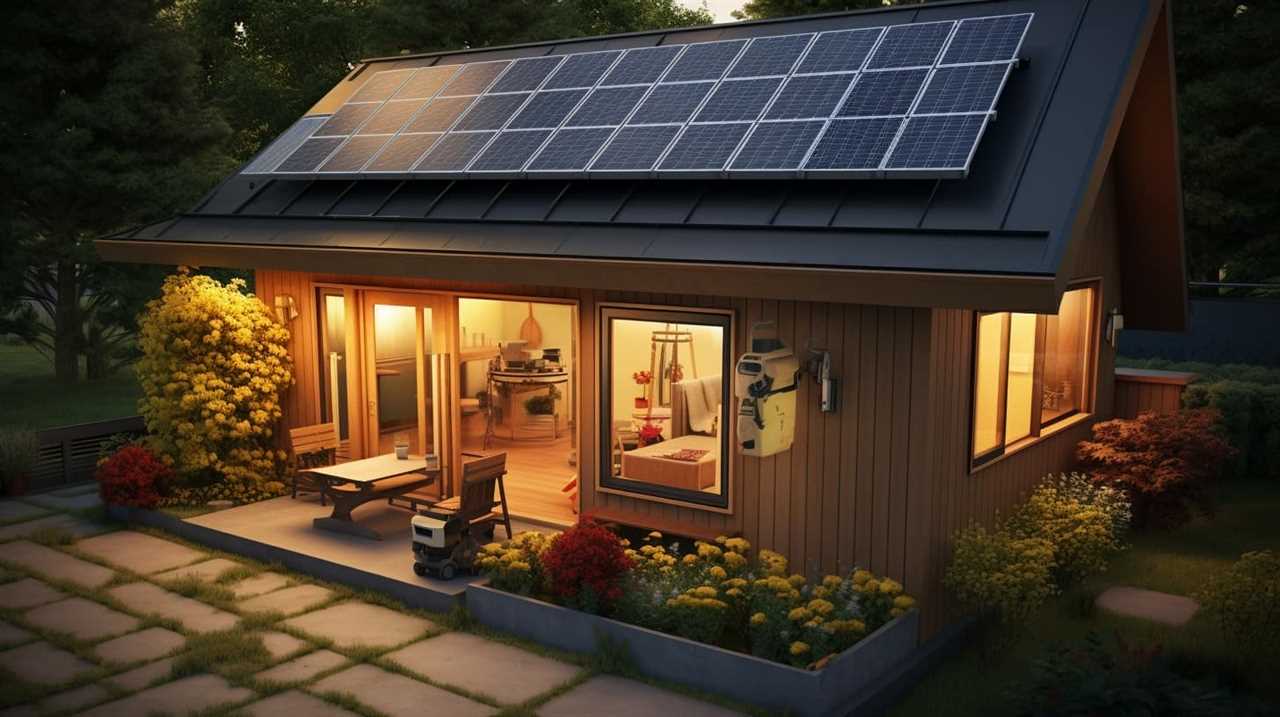
-
Cost savings: By using energy-efficient solutions, you can significantly reduce your heating and cooling costs. Smart thermostats can help you save money by automatically adjusting the temperature when you’re away or asleep, preventing unnecessary energy consumption.
-
Environmental impact: By reducing energy waste, smart thermostat systems contribute to a more sustainable lifestyle. By using these systems, you can minimize your carbon footprint and make a positive impact on the environment.
-
Comfort and convenience: Smart thermostats offer personalized comfort by allowing you to set temperature preferences based on your needs. You can create schedules, set up zones, and even receive alerts and reminders to ensure your tiny house is always at the perfect temperature.
Frequently Asked Questions
What Are the Best Materials for Insulating a Tiny House While Traveling?
The best materials for insulating a tiny house while traveling include spray foam insulation, rigid foam insulation, and cellulose insulation. These options provide excellent thermal resistance and help maintain a comfortable temperature inside the mobile home.
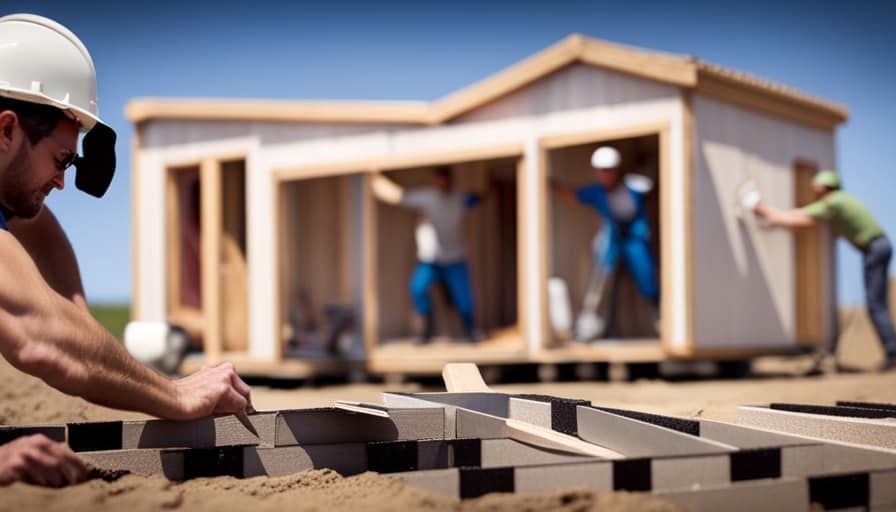
How Do I Prevent Heat Loss Through Windows in My Tiny House While on the Road?
To prevent heat loss through windows in my tiny house while on the road, I make sure to use insulating curtains and weather stripping. I also manage humidity levels to prevent condensation buildup.
Are There Any Heating Options Specifically Designed for Off-Grid Tiny House Travel?
There are heating options designed for off-grid tiny house travel. Insulation materials can help maintain temperature. It’s important to choose efficient heating systems and insulate well to ensure comfort while traveling.
What Are Some Effective Cooling Solutions for Hot Climates When Traveling in a Tiny House?
When traveling in a tiny house, it’s important to have effective cooling methods for hot climates. One solution is to use energy efficient insulation to keep the interior cool and comfortable.
Can I Install a Smart Thermostat System in My Tiny House to Regulate Temperature While on the Road?
Yes, you can install a smart thermostat system in your tiny house for temperature regulation while traveling. It’s a practical solution that allows you to control the temperature remotely and maintain a comfortable environment wherever you go.
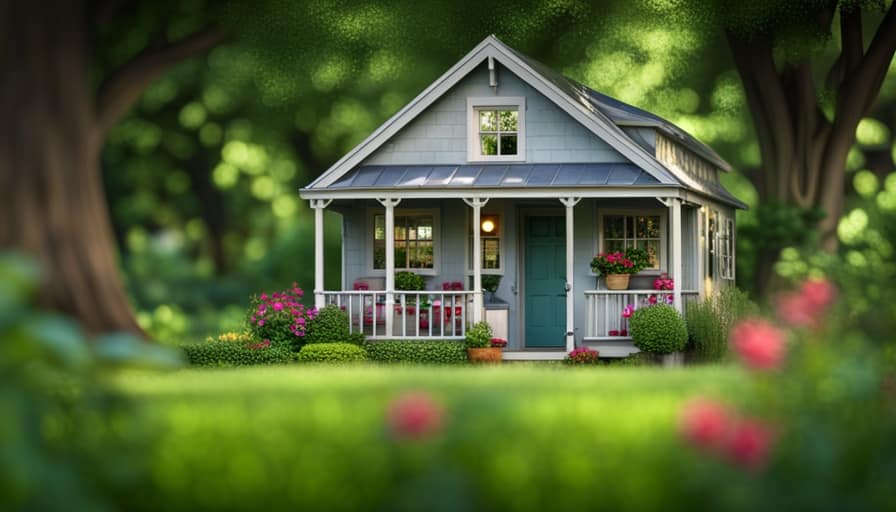
Conclusion
In conclusion, maintaining a comfortable temperature in a tiny house while traveling requires proper insulation, suitable heating options, effective cooling solutions, maximizing airflow, and utilizing smart thermostat systems.
As the saying goes, ‘An ounce of prevention is worth a pound of cure.’ By taking the necessary steps to control temperature, you can ensure a cozy and enjoyable journey in your tiny home on wheels.
Stay cozy and safe travels!
I’m Theodore, and I love tiny houses. In fact, I’m the author of Tiny House 43, a book about tiny houses that are also tree houses. I think they’re magical places where imaginations can run wild and adventures are just waiting to happen.
While tree houses are often associated with childhood, they can be the perfect adult retreat. They offer a cozy space to relax and unwind, surrounded by nature. And since they’re typically built on stilts or raised platforms, they offer stunning views that traditional homes simply can’t match.
If you’re looking for a unique and romantic getaway, a tree house tiny house might just be the perfect option.
Tiny Houses
How Do You Finance a Tiny House

As someone who dreams of living in a cozy, pint-sized paradise, I often contemplate how to turn that dream into a reality. How can I secure financing for a tiny house?
In this article, we will explore various financing options, from personal savings to loans and even creative strategies. Join me on this journey as we navigate the world of tiny house financing, uncovering the pros and cons, and finding the best path to turn our small space dreams into a cherished reality.
Key Takeaways
- Personal financing options such as utilizing personal savings, withdrawing from retirement accounts, and consulting with a financial advisor are common methods for financing a tiny house.
- Tiny house loans offer flexibility in repayment terms and the opportunity to build credit history, but they often come with high interest rates and limited availability of lenders.
- Crowdfunding can be a viable option for financing a tiny house, as it allows individuals to gather funds from a wide audience and benefit from community support. However, there is no guarantee of reaching the funding goal.
- RV loans can be used to finance a tiny house, but it is important to research lenders specializing in RV loans, compare interest rates and loan terms, and consider the influence of credit score and financial history.
Exploring Personal Savings as a Financing Option
I can use my personal savings as a financing option for a tiny house. When exploring alternative financing options, utilizing retirement funds can be a viable choice. Many individuals have built up a significant amount of savings over the years, and tapping into those funds can provide a means to finance a tiny house.
By using personal savings, individuals can avoid taking on debt and the associated interest payments. This option allows for greater financial freedom and flexibility, as there are no strict repayment schedules or loan terms to adhere to.
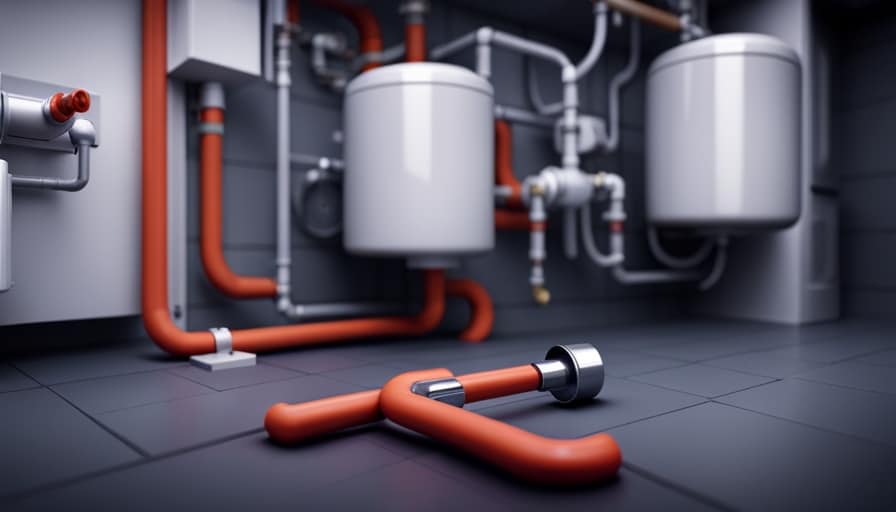
However, it’s crucial to consider the long-term implications of using retirement funds, as withdrawing from these accounts may have tax consequences and can impact one’s future financial security. It’s advisable to consult with a financial advisor to determine the best course of action when utilizing personal savings for a tiny house.
Understanding the Pros and Cons of Tiny House Loans
One major advantage of tiny house loans is that they provide individuals with the opportunity to secure financing for their dream home. However, it is important to weigh the pros and cons before deciding on this financing option. Here is a table outlining the advantages and disadvantages of tiny house loans:
| Pros | Cons |
|---|---|
| Provides financing for a dream home | High interest rates |
| Allows for flexibility in repayment terms | Limited availability of lenders |
| Can help build credit history | Potential difficulty in getting approved |
While tiny house loans offer the advantage of making homeownership possible for those who may not have enough savings, there are also some drawbacks to consider. High interest rates can make the loan more expensive over time, and finding lenders who specialize in tiny house loans can be challenging. Additionally, getting approved for a loan may be more difficult compared to traditional mortgages. As with any financial decision, it is essential to carefully evaluate the pros and cons and consider alternative financing options for tiny houses.
Crowdfunding Your Tiny House: Is It a Viable Option
Crowdfunding your tiny house can be a viable option to gather funds for your dream home. In recent years, crowdfunding has gained popularity as an alternative funding method for various projects, including tiny house construction. This approach allows individuals to reach out to their communities and beyond, seeking support for their housing endeavors.

One of the key advantages of crowdfunding is the potential for community support. By sharing your project on crowdfunding platforms and social media, you can reach a wide audience of potential backers who are passionate about tiny houses or sustainable living. These individuals may be willing to contribute financially to help you achieve your goal.
Furthermore, crowdfunding offers a unique opportunity to showcase your creativity and vision. With compelling storytelling and engaging visuals, you can capture the attention and interest of potential backers, inspiring them to invest in your tiny house project.
However, it’s important to recognize that crowdfunding success isn’t guaranteed. It requires careful planning, effective marketing, and a compelling value proposition to attract backers. Additionally, there’s no guarantee that you’ll reach your funding goal, and you may need to consider alternative options if crowdfunding falls short.
Navigating the World of RV Loans for Your Tiny House
Securing an RV loan for my tiny house was a crucial step in financing my dream home. When it comes to alternative financing options, RV loans are a popular choice for many tiny house enthusiasts. Finding affordable RV loans requires some research and careful consideration.
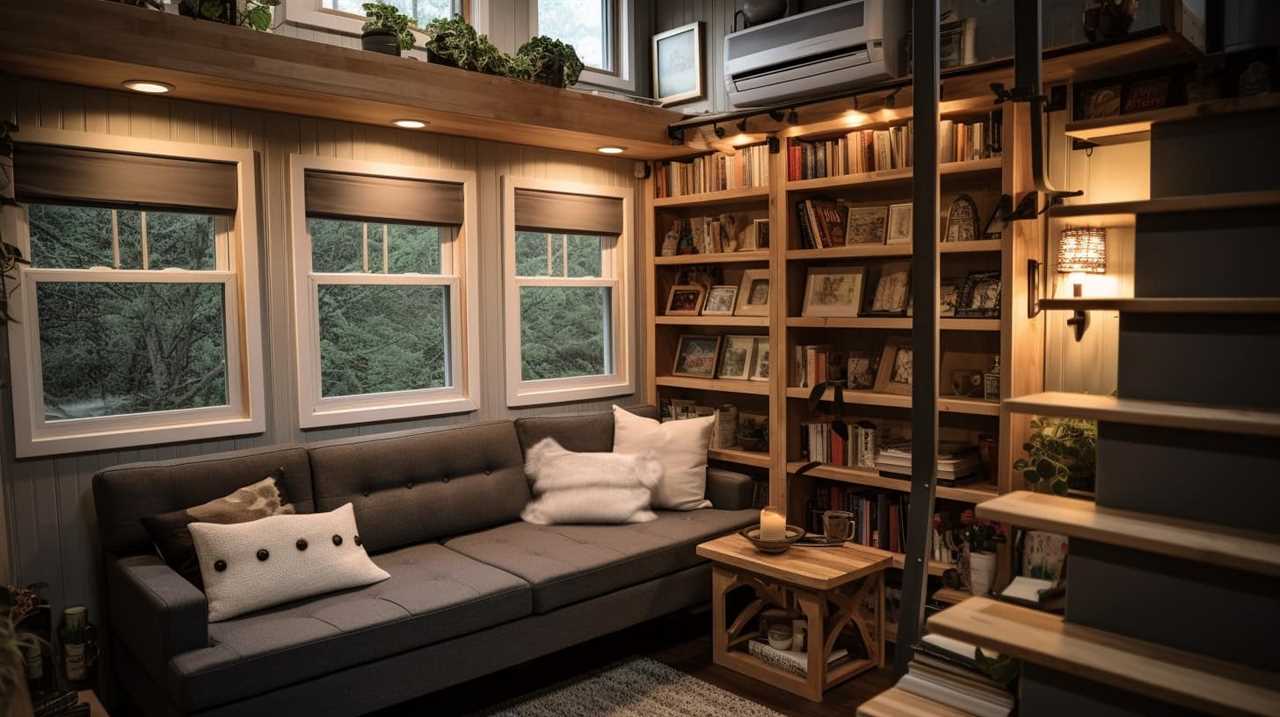
One of the first things I did was to explore different lenders that specialize in RV loans. I compared interest rates, loan terms, and requirements to ensure I was getting the best deal possible. Additionally, I made sure to have a good credit score and a solid financial history, as this greatly influences the loan approval process.
It’s important to note that not all lenders offer RV loans for tiny houses, so it’s essential to find those who do. By taking the time to navigate the world of RV loans, I was able to secure the financing I needed to make my tiny house dreams a reality.
Creative Financing Strategies for Your Tiny House Dream
Exploring alternative financing options became crucial in pursuing my tiny house dream. When traditional lending institutions didn’t offer suitable solutions, I had to think outside the box and consider creative strategies.
Here are some alternative funding options to consider:
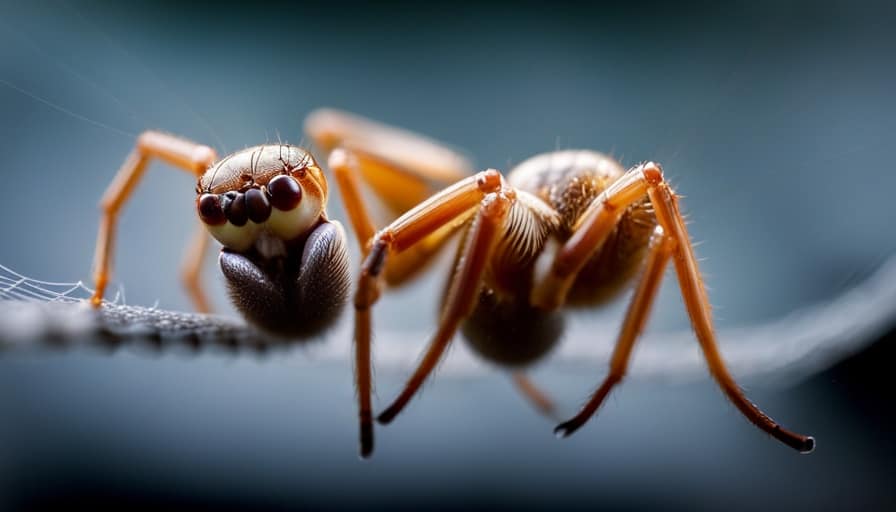
-
Personal Loans: I researched online platforms that connect borrowers with individual lenders who are willing to fund unconventional projects like tiny houses. This allowed me to secure a loan with flexible terms and competitive interest rates.
-
Crowdfunding: I created a compelling campaign on crowdfunding platforms specifically tailored for tiny house projects. By sharing my story and vision, I was able to attract support from like-minded individuals who believed in my dream.
-
Negotiating with Local Banks: I approached local banks and credit unions, explaining the unique nature of tiny house living and emphasizing the environmental and financial benefits. Some institutions were open to discussing customized loan options that better suited my needs.
Frequently Asked Questions
Are There Any Grants or Government Programs Available to Help Finance a Tiny House?
There are grants and government programs available to help finance a tiny house. Additionally, crowdfunding can be a viable option for raising funds. These options provide opportunities for individuals to obtain financial assistance for their tiny house projects.
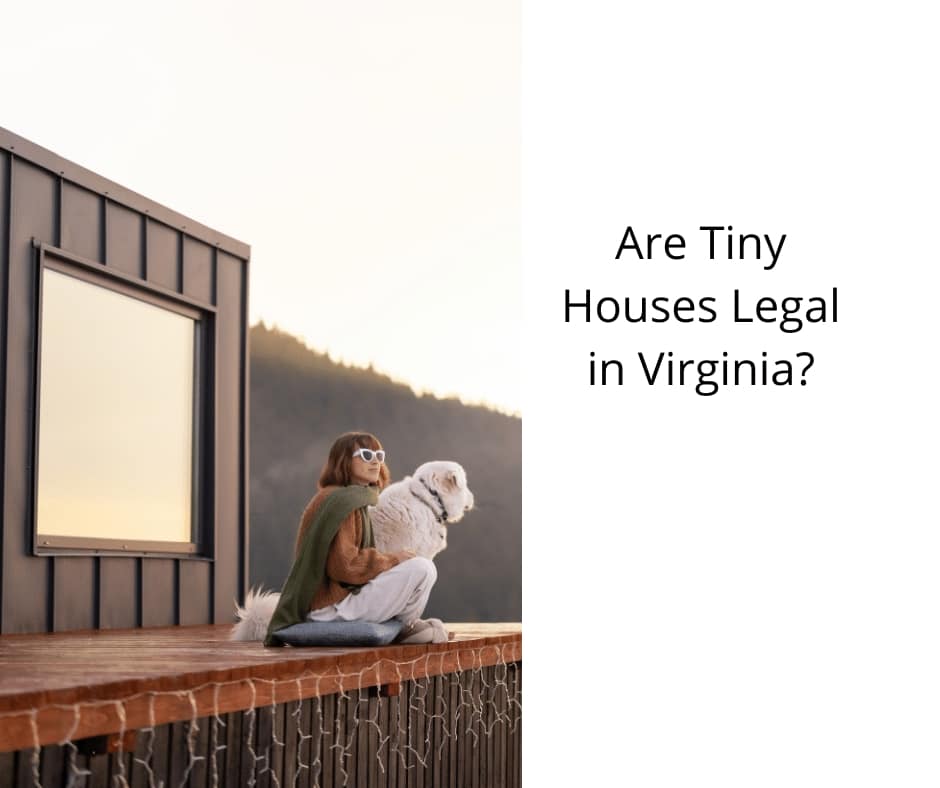
Can I Use a Personal Loan or Credit Card to Finance My Tiny House?
Sure, I can use a personal loan or credit card to finance my tiny house. There are several personal loan options available, and alternative financing methods can also be explored.
What Are the Tax Implications of Financing a Tiny House?
Tax deductions and financial planning are essential considerations when financing a tiny house. It’s crucial to understand the potential tax implications and seek professional advice to ensure you make informed decisions about your finances.
Can I Rent Out My Tiny House to Help Generate Income and Offset the Cost of Financing?
Renting out my tiny house is a smart move to generate income and offset financing costs. It’s one of the alternative financing options available. By doing so, I can maximize the benefits of my investment.
Are There Any Special Insurance Requirements for Financing a Tiny House?
There are special insurance requirements when financing a tiny house. It is important to have coverage for both the structure and contents. The advantages of financing a tiny house include lower costs and increased flexibility.
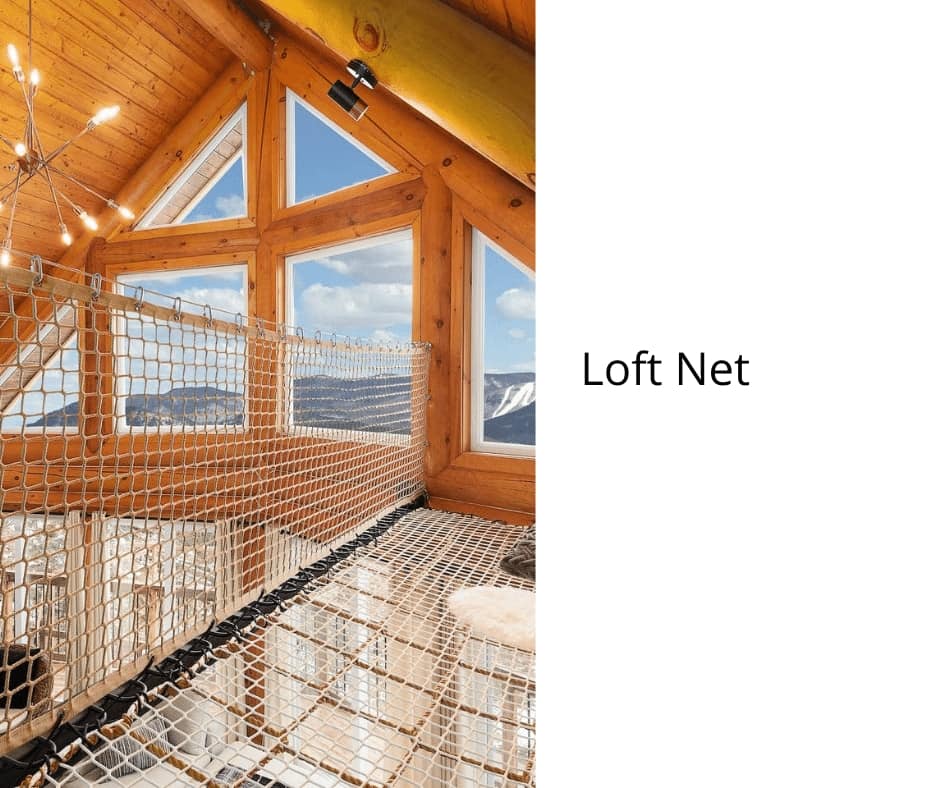
Conclusion
In conclusion, financing a tiny house requires careful consideration of various options. Personal savings can be a reliable choice, allowing individuals to fund their dream home without incurring debt.
However, for those in need of additional financial support, exploring tiny house loans or crowdfunding can be viable alternatives. Additionally, RV loans offer flexibility for those opting for a mobile tiny house lifestyle.
Ultimately, the choice of financing will depend on individual circumstances and preferences. For example, Sarah, a freelance writer, successfully financed her tiny house through a combination of personal savings and a small loan from a local credit union.
I’m Theodore, and I love tiny houses. In fact, I’m the author of Tiny House 43, a book about tiny houses that are also tree houses. I think they’re magical places where imaginations can run wild and adventures are just waiting to happen.
While tree houses are often associated with childhood, they can be the perfect adult retreat. They offer a cozy space to relax and unwind, surrounded by nature. And since they’re typically built on stilts or raised platforms, they offer stunning views that traditional homes simply can’t match.
If you’re looking for a unique and romantic getaway, a tree house tiny house might just be the perfect option.
Tiny Houses
How Do You Finance to Build a Tiny House
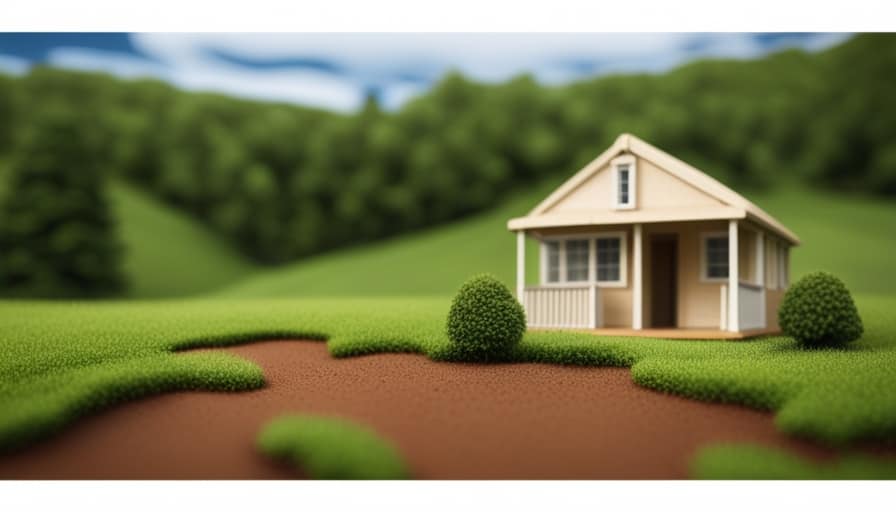
I will demonstrate how you can finance your dream of constructing a tiny house. Were you aware that more than 60% of tiny house owners do not have a mortgage?
In this article, I’ll share practical tips and strategies to help you secure funding for your tiny house project. From government programs and grants to exploring alternative financing methods, we’ll explore all the options available.
Whether it’s crowdfunding, community support, or DIY financing strategies, I’ve got you covered.
Let’s make your tiny house dreams a reality!
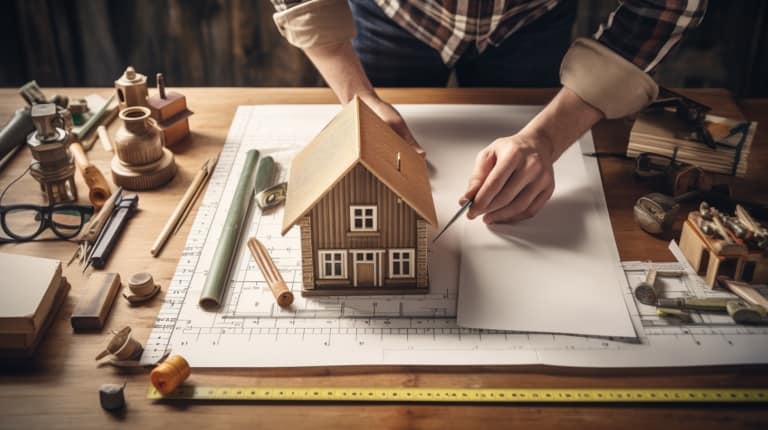
Key Takeaways
- Government programs and grants can provide financial support for building a tiny house.
- Traditional loan options, such as home equity loans and personal loans, can be explored for financing a tiny house project.
- Exploring alternative financing methods, such as crowdfunding and lease financing, can provide more options for funding a tiny house project.
- DIY financing strategies, such as budgeting and leveraging existing assets, empower individuals to take control of their tiny house project.
Government Programs and Grants
I can explore government programs and grants to help finance my tiny house. There are various government assistance programs available that can provide financial support for building a tiny house. These programs aim to promote affordable housing options and sustainable living.
One option is to look into grants specifically designed for individuals looking to build a tiny house. These grants can help cover the costs of materials and construction. Additionally, there may be tax incentives available for those who choose to build a tiny house. These incentives can help offset the costs of building and owning a tiny house.
By taking advantage of government programs and grants, I can significantly reduce the financial burden of building my own tiny house.
Transitioning into the subsequent section about ‘tiny house loans: traditional options’, I can also explore other financing options to supplement government assistance and grants.
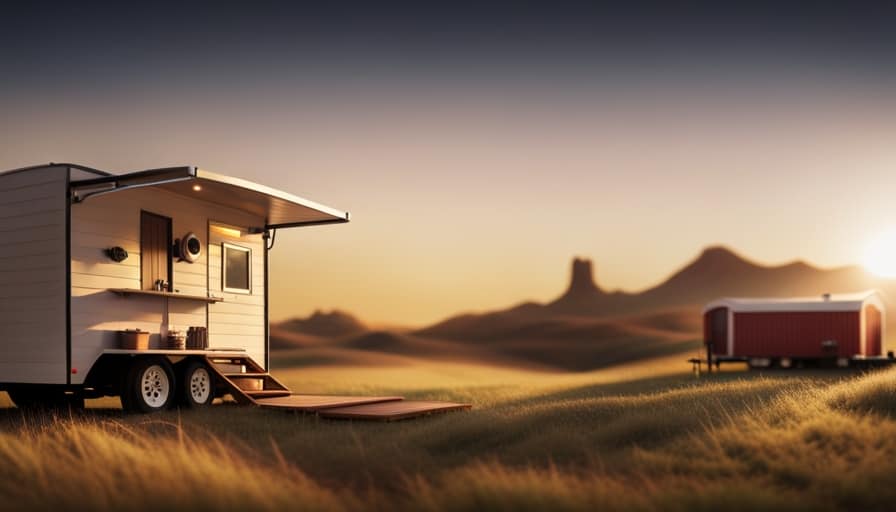
Tiny House Loans: Traditional Options
There are several traditional options available for obtaining a loan to finance a tiny house. Here are some of them:
-
Home Equity Loan: If you already own a property with equity, you may be able to use it as collateral to secure a loan for your tiny house project. This type of loan allows you to borrow against the value of your home.
-
Personal Loans: Another option is to apply for a personal loan. These loans are typically unsecured, meaning you don’t have to put up any collateral. However, keep in mind that interest rates may be higher compared to other loan options.
-
Traditional Mortgage: While not specifically designed for tiny houses, you can explore traditional mortgage options. This may require finding a lender who’s willing to finance a non-traditional dwelling.
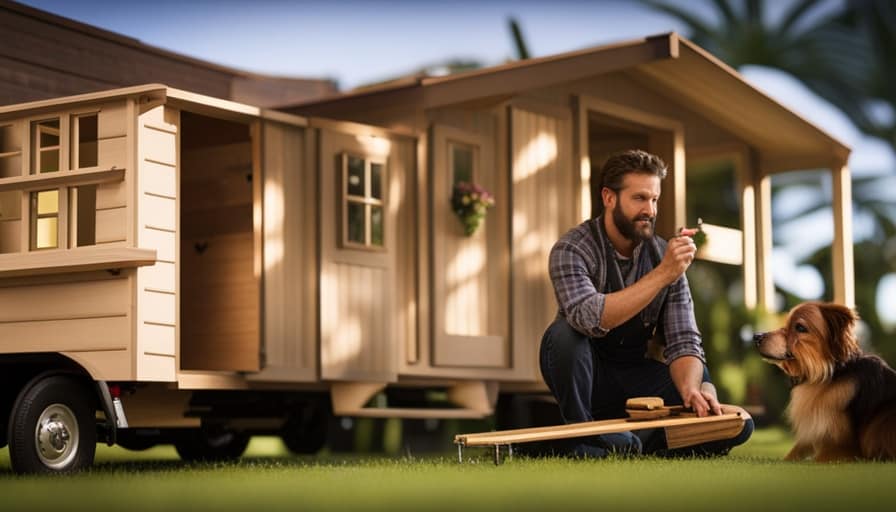
-
Credit Union Loans: Credit unions often offer competitive rates and personalized service. They may have specific loan programs tailored for tiny houses.
These traditional loan options provide various avenues for financing your tiny house project. However, if you’re looking for alternative financing methods, there are other options to explore.
[Transition into the subsequent section about ‘exploring alternative financing methods’]
Exploring Alternative Financing Methods
One option to consider is combining personal savings and crowdfunding to finance a tiny house project. This approach allows you to leverage your own resources while also tapping into the support of others who believe in your vision. By using your personal savings, you can contribute a significant amount towards the construction costs of your tiny house. This demonstrates your commitment and reduces the amount you need to borrow.

Crowdfunding platforms provide an opportunity to raise additional funds from a wider network of people who are interested in supporting unique and sustainable housing projects.
Another alternative financing method to explore is lease financing. This involves leasing the land where you plan to park your tiny house, which can help lower upfront costs and provide flexibility in terms of location.
Crowdfunding and Community Support
Combining personal savings with crowdfunding and community support can be a powerful way to finance a tiny house project. Here are some ways to leverage these resources:
-
Personal savings and investments: Start by assessing your own financial situation and determine how much you can contribute towards your tiny house project. Consider using your savings or even exploring investment options to increase your funds.
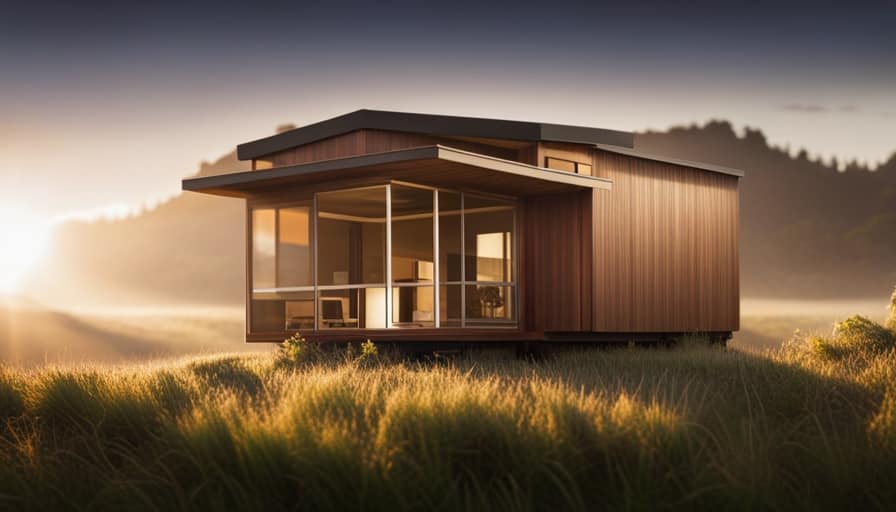
-
Crowdfunding: Platforms like Kickstarter and GoFundMe allow you to create a campaign and raise money from a large number of people. Share your story, explain your vision, and offer rewards for different levels of support. Engaging with your community can be a great way to generate funds.
-
Sponsorship and partnerships: Reach out to local businesses, organizations, and individuals who may be interested in supporting your project. Offer advertising opportunities or collaborate on mutually beneficial initiatives. Building these strategic partnerships can provide financial support and help raise awareness for your tiny house project.
-
Community support: Tap into the power of your community by hosting fundraising events, organizing volunteer days, or seeking in-kind donations. Engaging with your neighbors and demonstrating your commitment to serving others can inspire support and make your project a community effort.
DIY Financing Strategies
Two popular DIY financing strategies are budgeting and leveraging existing assets. When it comes to building a tiny house, these strategies can be effective in helping you secure the necessary funds.

The first strategy, budgeting, involves carefully planning and tracking your expenses to save money over time. By creating a realistic budget and cutting unnecessary costs, you can allocate more funds towards your tiny house project.
The second strategy, leveraging existing assets, involves using your home equity or personal savings to finance the construction. Home equity can be accessed through a home equity loan or line of credit, while personal savings can be used to cover the upfront costs.
Both of these strategies require discipline and careful financial planning, but they can provide a viable path to financing your tiny house project.
Frequently Asked Questions
What Are the Eligibility Requirements for Government Programs and Grants for Financing a Tiny House?
To finance a tiny house, I researched government programs, grants, and eligibility requirements. I also considered traditional home loans and unique financing options like crowdfunding. DIY financing strategies were explored to find the best fit for my situation.
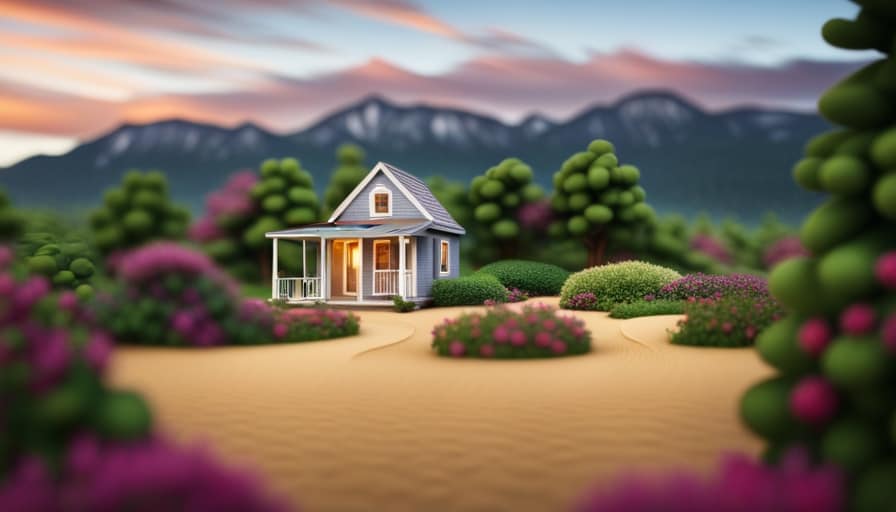
Can You Use a Traditional Home Loan to Finance the Construction of a Tiny House?
Using a traditional home loan to finance a tiny house may not be feasible due to size and zoning restrictions. However, there are alternative financing options such as personal loans, RV loans, or crowdfunding that can help fund your tiny house dream.
Are There Any Unique Financing Options Available for Tiny House Projects, Other Than Traditional Loans?
There are unique financing options and alternative funding sources available for tiny house projects, aside from traditional loans. These options can provide flexibility and tailor-made solutions to suit your specific needs and circumstances.
How Does Crowdfunding Work as a Financing Method for Building a Tiny House?
Crowdfunding can be a helpful financing method for building a tiny house. It offers benefits like access to a wider pool of potential investors, but also comes with challenges such as the need to market your project effectively to attract donations.
What Are Some DIY Financing Strategies That Can Help in Funding the Construction of a Tiny House?
When it comes to financing the construction of a tiny house, there are several DIY options to explore. From tapping into the power of tiny house crowdfunding to creative budgeting techniques, these strategies can help make your dream home a reality.
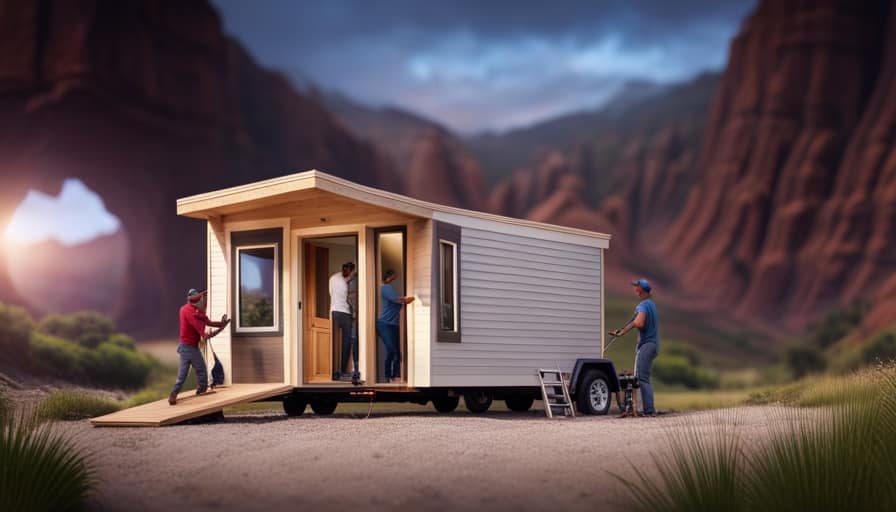
Conclusion
In conclusion, financing a tiny house can be a challenge but there are various options available. Government programs and grants, traditional loans, and alternative financing methods can provide financial assistance. Additionally, crowdfunding and community support can help gather funds.
It’s interesting to note that according to a survey, 67% of tiny house owners have been able to pay off their mortgages in less than 10 years, highlighting the affordability and financial benefits of this lifestyle.
I’m Theodore, and I love tiny houses. In fact, I’m the author of Tiny House 43, a book about tiny houses that are also tree houses. I think they’re magical places where imaginations can run wild and adventures are just waiting to happen.
While tree houses are often associated with childhood, they can be the perfect adult retreat. They offer a cozy space to relax and unwind, surrounded by nature. And since they’re typically built on stilts or raised platforms, they offer stunning views that traditional homes simply can’t match.
If you’re looking for a unique and romantic getaway, a tree house tiny house might just be the perfect option.
-

 Beginners Guides2 weeks ago
Beginners Guides2 weeks agoHow To Buy A Tesla Tiny House
-

 Energy Efficiency2 months ago
Energy Efficiency2 months agoBest Tiny Homes For Cold Climates
-

 Beginners Guides2 weeks ago
Beginners Guides2 weeks agoTiny House Nation Where Are They Now Stephanie
-

 Tiny House Resources (e.g., legalities, cost, insurance, FAQs)2 months ago
Tiny House Resources (e.g., legalities, cost, insurance, FAQs)2 months agoDo Tiny Homes Need Planning Permission?
-

 Beginners Guides3 weeks ago
Beginners Guides3 weeks agoFrom The Show Tiny House Nation How Many Keep Their Tiny House?
-

 Beginners Guides2 months ago
Beginners Guides2 months agoUsing a Climbing Net For Treehouse Construction
-

 Beginners Guides2 months ago
Beginners Guides2 months agoHow to Build a Treehouse Without Drilling Into the Tree
-

 Beginners Guides4 weeks ago
Beginners Guides4 weeks agoTiny House Nation Who Pays For The Houses

















